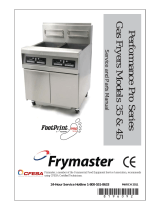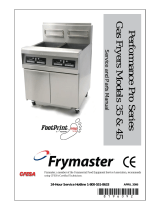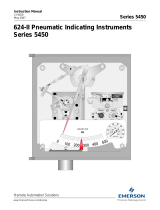Page is loading ...

Installation Instructions
Document No. 129-078
March 15, 2022
Free Energy Band™ TH193 HC
Heating/Cooling Room Thermostat
Item Number 129-078+3, Rev DA Page 1 of 4
Product Description
The TH193 HC thermostats are proportional dual
output, dual setpoint, two-pipe (dual one-pipe, low
air capacity) or three-pipe (dual two-pipe, high air
capacity) temperature controllers. Each TH193 HC
chassis includes a wall plate for thermostat
installation using a variety of rough-in installation
kits.
Prerequisites
• Review all instructions before beginning
installation.
• Verify job drawings are available to reference
specific job site information as needed.
• Verify rough-in installation kits (wall-box or
tubing runs) are pre-installed.
Expected Installation Time
30 Minutes
Required Tools
• Medium flat-blade screwdriver
• Needle nose pliers
• Small level
• Calibration and cover screw wrench or 1/16-
inch Allen wrench (P/N 192-632)
• Needle Probe with 1-1/2 inch diameter, 0 to
30 psig (0 to 200 kPa) test gauge
(P/N 192-633)
Warning/Caution Notations
WARNING
Personal injury or loss of life
may occur if a procedure is not
performed as specified.
CAUTION
Equipment damage or loss of
data may occur if the user
does not follow a procedure as
specified.
Installation
Overview
The TH193 HC thermostat and wall plate mount
vertically to a wall using a variety of rough-in
installation kits (for example, wall box kits or tubing
terminal kits). The ends of the air lines from the
rough-in installation kits have terminal adapters that
snap into the wall plate. Terminal adapters are also
available separately as orderable accessories. See
TB 237 (155-244P25).
NOTE: Certain retrofit applications allow air
connections directly to the thermostat
chassis.
The S, R1, and R2 labels on both the thermostat
chassis and the wall plate identify the air line
connections. The thermostat plugs into the terminal
adapters on the wall plate. See Piping for typical
connections.
Two cover screws plus latch arms on the wall plate
hold the thermostat in place. The cover fits over the
thermostat and the two cover screws fasten it to the
wall plate.
Procedure
The following procedure is for a typical thermostat
installation and assumes the rough-in installation kit
is in place. See Figure 1.
1. The rough-in installation kit provides a supply
(blue) air line and a return air line joined by an
air link. Remove the terminal adapters from the
air link and snap them into the wall plate at their
respective locations.
2. Using the mounting screws supplied with the
thermostat chassis, install the wall plate on the
wall as follows:
a. Guide the screws through the slotted
keyholes on the wall plate and partially insert
them into wall.
b. Orient the wall plate so that it is square and
level.
c. Tighten the mounting screws to secure the
wall plate in place.

Document No. 129-078
Installation Instructions
March 15, 2022
Page 2 of 4 Siemens Industry, Inc.
3. Moisten the thermostat supply and return ports
to lubricate them. Carefully insert the thermostat
ports into the terminal adapter O-rings on the
wall plate.
4. Mount the cover over the thermostat.
NOTE: For applications that use the 1/2-inch
setpoint adjustment knob, align the
keyhole in the cover over the shaft
protruding from the thermostat when
mounting the cover.
Use the hex key end of the calibration and cover
screw wrench or a 1/16-inch Allen wrench to
tighten the two screws that secure the cover in
place.
5. Place the optional 1/2-inch setpoint adjustment
knob on the shaft protruding through the cover.
Use the hex key end of the calibration and cover
screw wrench or a 1/16-inch Allen wrench to
tighten the set screw on the knob.
The installation is complete.
Figure 1. Thermostat Installation (using 192-481
Tubing Terminal Kit and 182-685 Dry Wall Mounting
Kit.)
Remodeling Installation Reference
When converting from Model TH180 or TH182 to the
TH19X, you need:
• TH193 HC Chassis.
• A new cover. The TH180 or TH182 cover
does not fit the TH19X chassis or vice versa.
• Terminal adapters. These adapters are
required to retain the plug-in feature only.
Otherwise, 5/32-inch (4 mm) tubing can
connect directly to the thermostat chassis.
Use compression rings (P/N 141-388) to
secure connections.
When converting from competitor models to the
TH19X, you need:
• TH193 HC FEB Chassis.
• New cover.
• Adapter Kit (see TB 214, TH192 Adapter Kits
Technical Bulletin, 155-231P25).
Piping
NOTE: All piping (Figures 2 and 3) must conform to
local codes and regulations and must
comply with the local authority having
jurisdiction.
Figure 2. TH193 HC Thermostat Dual One-Pipe
Connections.
Figure 3. TH193 HC Thermostat Dual Two-Pipe
Connections.
Thermometer Calibration
1. Use a test thermometer to read the current room
temperature.
2. Place a screwdriver in the center of the
thermometer assembly (Figure 4). Carefully
rotate the thermometer assembly until the
pointer tip indicates the correct room
temperature.
NOTE: Avoid breathing on or touching the
bimetal spiral since this affects the
temperature reading.

Document No. 129-078
Installation Instructions
March 15, 2022
Siemens Industry, Inc. Page 3 of 4
Thermometer Calibration,
Continued
Figure 4. TH193 HC Thermostat Details.
Limit Stop Adjustment
Thermostat limit stops define the minimum and
maximum thermostat setpoints. The limit stops
engage in the setpoint cam gear teeth and cause
interference between the setpoint cam gear and the
adjustment knob gear.
To change the limit stop settings, use a needle nose
pliers to pull limit stop (Figure 4) between the setpoint
cam gear teeth. Do not pull the limit stop any more
than necessary to clear the gear teeth. Rotate the
limit stop to its new position. Changing the limit stop
position one gear tooth changes the limit stop setting
by 1-1/3F (0.7C).
Sensitivity Adjustment
The factory thermostat sensitivity setting is
approximately 2.5 psi/F (31 kPa/C). To change the
sensitivity, use a flat-blade screwdriver to carefully
move the sensitivity slide (Figure 4) to the desired
position as follows:
Graduation closest
to the rigid end of
the bimetal element
4 psi/F (50 kPa/C)
Graduation closest to
the minimum (MIN) end
of the bimetal element
1 psi/F (12 kPa/C)
NOTE: If the thermostat sensitivity is adjusted,
recalibrate the thermostat.
Thermostat Calibration
The thermostat is factory-calibrated to a control
pressure of 7.5 psi (52 kPa) when the setpoint and
the ambient temperature are both at 72°F (22°C). No
adjustments are required if these settings are
appropriate.
If the thermostat has been tampered with, the
sensitivity changed, or it is out of adjustment, use the
following procedures to recalibrate the instrument.
The output pressure test port (Figure 5) is accessible
without removing the thermostat cover through the
8th opening from the top as follows:
• For one-pipe thermostats, the test port is on the
right side.
• For two-pipe thermostats, the test port is on the
left side.
Figure 5. TH193 HC Output Pressure
Heating Test Port.
CAUTION:
If you use the wrong test port,
thermostat damage can occur and
result in replacement of the device.
Cooling Calibration
1. Remove the cover using the calibration tool.
Verify that the room temperature is between 70°F
and 80F (21°C and 27C).
2. Verify that the supply pressure is 25 psi
(172 kPa). Set the cooling dial to the room
temperature by turning the exposed adjustment
knob or using a hex key as shown. Allow the
thermostat to stand for about five minutes to
adjust to the new setting.
3. Moisten the needle and insert the test gauge and
needle adapter in the cooling test port. Read the
control pressure.
4. Check the control pressure. If it does not read 7
to 8 psi (48 to 55 kPa), turn the calibration screw
(Figure 4) using the calibration tool or a 1/8-inch
(3.2 mm) wrench until the pressure is 7 to 8 psi
(48 to 55 kPa). The sensing element is now in
calibration and the setpoint can be changed to
the desired room temperature.

Document No. 129-078
Installation Instructions
March 15, 2022
Information in this publication is based on current specifications. The company reserves the right to make changes in specifications and models
as design improvements are introduced. Free Energy Band is a trademark of Siemens Industry, Inc. Product or company names mentioned
herein may be the trademarks of their respective owners. © 2009-2022 Siemens Industry, Inc.
Siemens Industry, Inc.
Smart Infrastructure
Buffalo Grove, IL 60089-4513
USA
Tel. +1 847-215-1000
Your feedback is important to us. If you have
comments about this document, please send them
to sbt_technical.editor.us.[email protected]
Document No. 129-078
Printed in the USA
Page 4 of 4
Heating Calibration
1. If not already done, remove the cover using the
calibration tool. Verify that the room temperature
is between 70°F and 80F (21°C and 27C).
2. Verify that the supply pressure is 25 psi
(172 kPa). Set the heating dial to the room
temperature by turning the exposed adjustment
knob or using a hex key as shown. Allow the
thermostat to stand for about five minutes to
adjust to the new setting.
3. Moisten the needle and insert the test gauge and
needle adapter in the heating test port (Figure 5).
Read the control pressure.
4. Check the control pressure. If it does not read 7
to 8 psi (48 to 55 kPa), turn the calibration screw
(Figure 4) using the calibration tool or a 1/8-inch
(3.2 mm) wrench until the pressure is 7 to 8 psi
(48 to 55 kPa). The sensing element is now in
calibration and the setpoint can be changed to
the desired room temperature.
Troubleshooting
Before troubleshooting the thermostat (see Table 1),
make certain there is clean dry supply air at 18 psi
(124 kPa) minimum. Use the test probe gauge and
needle adapter to measure the control pressure at
the output pressure test port (Figure 5). The output
pressure test port is accessible without removing the
thermostat cover through the 8th opening from the
top as follows:
For one-pipe thermostats, the test port is on the
right side.
For two-pipe thermostats, the test port is on the
left side.
CAUTION:
If you use the wrong test port,
thermostat damage can occur and
result in replacement of the device.
Table 1. Troubleshooting Guide.
Problem
Check
Cause
Action
Control pressure
stays at
approximately
zero
Air supply
Low supply
pressure
As required
Nozzle or
flapper
Dirt on nozzle or
flapper
Clean nozzle or
replace
thermostat
Restrictor
Clogged restrictor
Replace
restrictor
Calibration
Out of calibration
Recalibrate
Control pressure
stays at
approximately
supply pressure
Nozzle
Clogged nozzle
Clean nozzle or
replace
thermostat
Calibration
Dirt on either
supply or exhaust
valve seat
Alternately close
and open nozzle
by gently
pushing down
the bimetal
Excessive air
leakage from
exhaust port on
left side of
thermostat
Supply and
return line
connection
Connections are
interchanged or
connection to port
is incorrect
As required
References
Document
Number
Free Energy Band TH193-4, TH193HC
Heating/Cooling Room Thermostat Technical
Instructions
155-068P25
TB 214, TH192 Adapter Kits Technical Bulletin
155-231P25
TB 237, Accessories for Installation of TH192,
Free Energy Band TH193, or TH194 Room
Thermostats Technical Bulletin
155-244P25
Dimensions
Figure 6. TH193 HC Dimensions in Inches (Millimeters).
/




